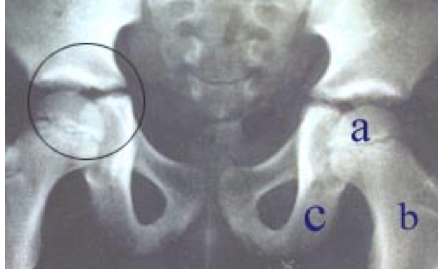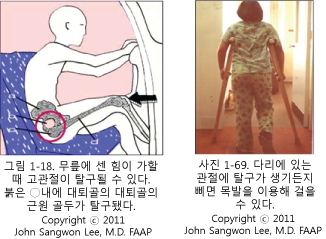Dislocations탈구
Overview of dislocation and its causes
Dislocation or dislocation of a part of the bone’s head (ball head) from the normal joint position is called dislocation or dislocation.
A part of the human body may be displaced from its normal position.
When the head of the bone in the articular capsule (ball head) is suddenly pulled, pushed, or twisted, the head of the ball comes out of the socket (extension) in the articular capsule slightly or out of the surrounding area is called dislocation.
Elbow joint (elbow joint), finger joint (finger joint), foot bone joint (ankle joint), hip joint (hip joint), knee joint (knee joint), shoulder joint (shoulder joint), temporomandibular joint, ankle joint, wrist joint, etc.
There are many types of joints in our body.
Theoretically, dislocations can occur in any joint.
There are also differences in the symptoms and symptoms of dislocation in each joint.
All types of dislocation symptoms, signs, diagnostic treatments cannot be described here.
So, some types of joint dislocations and general first aid methods for dislocations will be described.
When there is arthritis or myositis around the joints, which can destroy the joint capsule, dislocation can be easier, it can be congenital dislocation, or dislocation even if there is an abnormality in nerves or muscles, and it can be dislocated even if there is an abnormality in the central nerve.

Ligaments, muscles and joint capsules, peripheral nerves, blood vessels and soft tissues around the dislocated joint may be simultaneously damaged
([Parents should also be at least the half-i-doctors-Pediatric Family Nursing Encyclopedia]-Vol. 16 Pediatric Orthopedic Diseases- Congenital hip dislocation, hip joint abnormality formation, acquired hip dislocation, transient synovitis, dislocation, see Vol. 21, Child and Adolescent Home-School Nursing-Bandage).
Symptoms signs of dislocation
When a dislocated joint is dislocated, like when a joint is sprained, the dislocated joint cannot move properly.
The range of motion that can be actively moved is also limited.
In general, the dislocated joint is more swollen and more painful than the sprained joint, and the dislocated joint is rarely used normally.
Diagnosis of dislocation
Comprehensive diagnosis, such as medical history, symptom signs, and examination findings. If you suspect that you are dislocated, you can diagnose it with a joint X-ray examination.

Photo 1-69. Normal hip joint (hip joint) X-ray.
◯- hip joint (hip joint), a-proximal femur head, b-femur, c-sciatic bone. Copyrightⓒ 2011 John Sangwon Lee, MD., FAAP
Treatment of dislocation

First of all, if you suspect that a dislocation has occurred, stabilize the patient. If possible, call the medical paramedics, hospital emergency room, or regular pediatrics department in an emergency to make inquiries about first aid, and follow their instructions to start the first first emergency treatment at the accident site.
Even doctors cannot easily differentiate and diagnose whether there is a sprain in the joint by examining and facilitating the dislocated joint, whether there is a dislocation, a fracture in the joint bone forming the fracture, or a sprained fracture and a dislocation at the same time.
Depending on the situation, if possible, do not move the suspected joint or joint area as little as possible until your regular pediatrician or medical paramedic arrives at the scene, or until your doctor’s instructions.
Observational treatment is performed in the same position as the traumatic posture witnessed.
Call the regular pediatrics department, medical paramedics, or hospital emergency room for emergency help, or if you can’t get any other kind of help at the accident site, a joint suspected of being dislocated and the upper and lower parts of the joint A splint is placed on the body part, or, as soon as possible, it is transferred to a hospital emergency room where it can be treated while maintaining the position as soon as possible.
When applying a splint, do not push, pull, or twist the dislocated joint and the area around it.
As much as possible, the body position you first witnessed should remain intact and a splint should be applied. If the splint cannot be applied because there is no object for first aid, put it in the dislocated state, and use a sandbag, pillow, or blanket of stone horses as a splint to prevent the dislocated joint from moving well.
As such, first aid is given to the extent that the dislocated joint is supported and temporarily fixed, and taken to the hospital emergency room. In hospitals, joint X-ray examinations can be done to reliably diagnose whether a joint is sprained, dislocated, or fractured.
Treatment with plaster bandage treatment, surgical treatment, crutches treatment, splint treatment, etc., depending on which joint is severely dislocated and the severity of symptoms. When dislocated, it is generally ideal to seek medical attention from an orthopedic surgeon.
출처 및 참조문헌
- Quick Reference to Pediatric Emergencies, Delmer J. Pascoe, M.D.
- Emergency Pediatrics, A guide to ambulatory care, 5th Edi. Roger M. Barkin, Peter Rosen
- Emergency care and transportation of the sick and injured, American Academy of orthopedic surgeons.
- Nelson textbook, 15 edition
- Signs & Symptoms in Pediatrics 2nd edition
- The Johns Hopkins Hospital, The Harriet Lane Handbook, 18th edition
- Emergency Medical Service for Children, By Ross Lab. May 1989. p.10
- Emergency care, Harvey grant, and Robert Murray
- Emergency Care Transportation of Sick and Injured American Academy of Orthopaedic Surgeons
- Emergency Pediatrics A Guide to Ambulatory Care, Roger M. Barkin, Peter Rosen
- Quick Reference To Pediatric Emergencies, Delmer J. Pascoe, M.D., Moses Grossman, M.D. with 26 contributors
- Manual of Emergency Care 응급환자관리 정담미디어
- 소아가정간호백과-부모도 반의사가 되어야 한다, 이상원
- The pregnancy Bible. By Joan stone, MD. Keith Eddleman, MD
- Preparation for Birth. Beverly Savage and Dianna Smith
- 임신에서 신생아 돌보기까지. 이상원
- Breastfeeding. by Ruth Lawrence and Robert Lawrence
- Nelson Textbook of Pediatrics 14th ed. Beherman
- The Johns Hopkins Hospital, The Harriet Lane Handbook, 18th edition
- Red book 29th-31st edition 2021
- Nelson Text Book of Pediatrics 19th-21st Edition
- Infectious disease of children, Saul Krugman, Samuel L Katz, Ann A. Gershon, Catherine Wilfert
- The Harriet Lane Handbook 19th Edition
- Growth and Development of Children, George H. Lowrey 8th edition
- 소아과학 대한교과서
- 제1권 소아청소년 응급의료 참조문헌과 출처
- Other
Copyright ⓒ 2015 John Sangwon Lee, MD., FAAP
“부모도 반의사가 되어야 한다”-내용은 여러분들의 의사로부터 얻은 정보와 진료를 대신할 수 없습니다.
“The information contained in this publication should not be used as a substitute for the medical care and advice of your doctor. There may be variations in treatment that your doctor may recommend based on individual facts and circumstances. “Parental education is the best medicine.”